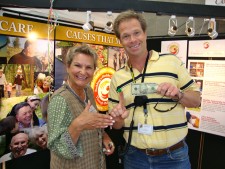Latest Weapon to Fight Distracted Driving: virtual reality by ![]() Edward C. Baig, USA TODA NEW YORK — AT&T is counting on virtual reality to help reduce the number of potentially fatal automobile accidents.
Edward C. Baig, USA TODA NEW YORK — AT&T is counting on virtual reality to help reduce the number of potentially fatal automobile accidents.
The wireless carrier is letting you take the wheel of a car virtually to simulate what can happen the instant you turn your attention away from the road to respond to a beeping cell phone or to text.
As you drive along suburban streets, and eventually a highway, the simulation presents everyday obstacles — kids in the crosswalk, cyclists and joggers, vehicles swerving in traffic — eventually to devastating effect.
It’s the latest tool in AT&T’s 5-year-old “It Can Wait” campaign which is designed to explain to you, or in this case to have you “experience,” the deadly consequences of distracted driving.
AT&T teamed up with the animation studio Reel FX to produce the impactful 360-degree VR simulation, which I got to try out while wearing Samsung Gear VR headgear. You can too.
AT&T is kicking off a 100-city tour today where people can check out the VR simulation by wearing Gear VR headgear and Bose noise-canceling headphones or by using the Google Cardboard VR viewer, of which AT&T will be distributing up to 100,000 for free at tour stops and other viewing events. You can visit ItCanWait.com/VR to download a free app that will work with Cardboard.
By AT&T’s own research, 7 in 10 people engage in smartphone activities while they drive. It’s not just texting and emailing either, though those remain the most prevalent behaviors.
“Although people admit that (such behavior) is terrible and that they do it, they don’t necessarily see themselves as part of the problem. What people are doing is rationalizing that there is a safe way to do it,” says Michelle Kuckelman, executive director of brand management at AT&T.
Adds Reel FX co-founder Dale Carman: We “purposely wanted to make this a linear experience that you couldn’t escape. One of the miracles of VR is you experience ‘presence.’ It worked on me.”
While AT&T has taken the lead on It Can Wait campaign, rival carriers Verizon, Sprint, and T-Mobile have lent their support to the campaign and the cause. AT&T says It Can Wait has inspired more than 7 million pledges to not text and drive.
To complement its virtual reality efforts, AT&T is also launching an ad campaign built around jarring 30-second TV commercials, one of which is shown here (and above), as well as a longer form video piece that will be shared through digital channels. With a compelling narrative and the use of slow-motion cinematography, viewers meet a mother and daughter in a car whose lives are altered when mom as the driver makes an unsafe choice with her phone. The ads were created by BBDO.
The commercials are disturbing in the same way that some of the harshest anti-tobacco ads are; the purpose, of course, is to raise awareness and stress the potential gravity of the situation.
There have been other impactful ads. In 2014, unsuspecting movie goers in a Hong Kong theater were watching an anti-texting and driving Volkswagen advertisement on the screen when their phones were made to ring. A second or so after audience members looked down at their phones, the car in the ad on the screen suddenly crashed.









